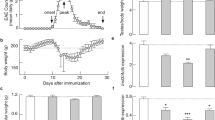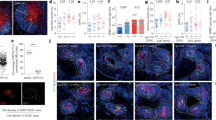Abstract
GPR54 is highly expressed in the central nervous system and plays a crucial role in pubertal development. However, GRP54 is also expressed in the immune system, implying possible immunoregulatory functions. Here we investigated the role of GPR54 in T cell and immune tolerance. GPR54 deficiency led to an enlarged thymus, an increased number of thymocytes, and altered thymic micro-architecture starting around puberty, indicating GPR54 function in T-cell development through its regulatory effect on the gonadal system. However, flow cytometry revealed a significant reduction in the peripheral regulatory T cell population and a moderate decrease in CD4 single-positive thymocytes in prepubertal Gpr54−/− mice. These phenotypes were confirmed in chimeric mice with GPR54 deficient bone marrow-derived cells. In addition, we found elevated T cell activation in peripheral and thymic T cells in Gpr54−/− mice. When intact mice were immunized with myelin oligodendrocyte glycoprotein, a more severe experimental autoimmune encephalomyelitis (EAE) developed in the Gpr54−/− mice. Interestingly, aggravated EAE disease was also manifested in castrated and bone marrow chimeric Gpr54−/− mice compared to the respective wild-type control, suggesting a defect in self-tolerance resulting from GPR54 deletion through a mechanism that bypassed sex hormones. These findings demonstrate a novel role for GPR54 in regulating self-tolerant immunity in a sex hormone independent manner.
Similar content being viewed by others
References
Adori, M., Kiss, E., Barad, Z., Barabás, K., Kiszely, E., Schneider, A., Kövesdi, D., Sziksz, E., Abrahám, I.M., and Matkó, J., et al. (2010). Estrogen augments the T cell-dependent but not the T-independent immune response. Cell Mol Life Sci 67, 1661–1674.
Blink, S., and Miller, S. (2009). The contribution of gammadelta T cells to the pathogenesis of EAE and MS. Curr Mol Med 9, 15–22.
Bosselut, R. (2004). CD4/CD8-lineage differentiation in the thymus: from nuclear effectors to membrane signals. Nat Rev Immunol 4, 529–540.
Chen, W.J., and Konkel, J.E. (2015). Development of thymic Foxp3+ regulatory T cells: TGF-ß matters. Eur J Immunol 45, 958–965.
Cho, S.G., Li, D., Stafford, L.J., Luo, J., Rodriguez-Villanueva, M., Wang, Y., and Liu, M. (2009). KiSS1 suppresses TNFa-induced breast cancer cell invasion via an inhibition of RhoA-mediated NF-kB activation. J Cell Biochem 107, 1139–1149.
Cho, S.G., Li, D., Tan, K., Siwko, S.K., and Liu, M. (2012). KiSS1 and its G-protein-coupled receptor GPR54 in cancer development and metastasis. Cancer Metastasis Rev 31, 585–591.
Clarke, S.A., and Dhillo, W.S. (2016). Kisspeptin across the human lifespan: evidence from animal studies and beyond. J Endocrinol 229, R83–R98.
Colledge, W.H. (2009). Transgenic mouse models to study Gpr54/kisspeptin physiology. Peptides 30, 34–41.
Davidson, T.S., DiPaolo, R.J., Andersson, J., and Shevach, E.M. (2007). Cutting edge: IL-2 is essential for TGF-beta-mediated induction of Foxp3+ T regulatory cells. J Immunol 178, 4022–4026.
de Roux, N., Genin, E., Carel, J.C., Matsuda, F., Chaussain, J.L., and Milgrom, E. (2003). Hypogonadotropic hypogonadism due to loss of function of the KiSS1-derived peptide receptor GPR54. Proc Natl Acad Sci USA 100, 10972–10976.
Funes, S., Hedrick, J.A., Vassileva, G., Markowitz, L., Abbondanzo, S., Golovko, A., Yang, S., Monsma, F.J., and Gustafson, E.L. (2003). The KiSS-1 receptor GPR54 is essential for the development of the murine reproductive system. Biochem Biophys Res Commun 312, 1357–1363.
Gallegos, A.M., and Bevan, M.J. (2006). Central tolerance: good but imperfect. Immunol Rev 209, 290–296.
Gorbunova, O.L., and Shirshev, S.V. (2014). The role of kisspeptin in immune tolerance formation during pregnancy. Dokl Biol Sci 457, 258–260.
Herbison, A.E., d’Anglemont de Tassigny, X., Doran, J., and Colledge, W. H. (2010). Distribution and postnatal development of Gpr54 gene expression in mouse brain and gonadotropin-releasing hormone neurons. Endocrinology 151, 312–321.
Horwitz, D.A., Zheng, S.G., Wang, J., and Gray, J.D. (2008). Critical role of IL-2 and TGF-ß in generation, function and stabilization of Foxp3+ CD4+ Treg. Eur J Immunol 38, 912–915.
Hu, Y. (2012). Isolation of human and mouse neutrophils ex vivo and in vitro. Methods Mol Biol 844, 101–113.
Jochems, C., Islander, U., Kallkopf, A., Lagerquist, M., Ohlsson, C., and Carlsten, H. (2007). Role of raloxifene as a potent inhibitor of experimental postmenopausal polyarthritis and osteoporosis. Arthritis Rheum 56, 3261–3270.
Karlsson, S.A., Haziri, K., Hansson, E., Kettunen, P., and Westberg, L. (2015). Effects of sex and gonadectomy on social investigation and social recognition in mice. BMC Neurosci 16, 83.
Kotani, M., Detheux, M., Vandenbogaerde, A., Communi, D., Vanderwinden, J.M., Le Poul, E., Brézillon, S., Tyldesley, R., Suarez-Huerta, N., and Vandeput, F., et al. (2001). The metastasis suppressor gene KiSS-1 encodes kisspeptins, the natural ligands of the orphan G protein-coupled receptor GPR54. J Biol Chem 276, 34631–34636.
Laurent, J., Bosco, N., Marche, P.N., and Ceredig, R. (2004). New insights into the proliferation and differentiation of early mouse thymocytes. Int Immunol 16, 1069–1080.
Lee, J.H., Miele, M.E., Hicks, D.J., Phillips, K.K., Trent, J.M., Weissman, B.E., and Welch, D.R. (1996). KiSS-1, a novel human malignant melanoma metastasis-suppressor gene. J Natl Cancer Inst 88, 1731–1737.
Lee, D.K., Nguyen, T., O’Neill, G.P., Cheng, R., Liu, Y., Howard, A.D., Coulombe, N., Tan, C.P., Tang-Nguyen, A.T., and George, S.R., et al. (1999). Discovery of a receptor related to the galanin receptors. FEBS Lett 446, 103–107.
Li, D., Yu, W., and Liu, M. (2009). Regulation of KiSS1 gene expression. Peptides 30, 130–138.
Liu, Y., Yin, Z., Zhang, R., Yan, K., Chen, L., Chen, F., Huang, W., Lv, B., Sun, C., and Jiang, X. (2014). MSCs inhibit bone marrow-derived DC maturation and function through the release of TSG-6. Biochem Biophys Res Commun 450, 1409–1415.
Makri, A., Pissimissis, N., Lembessis, P., Polychronakos, C., and Koutsilieris, M. (2008). The kisspeptin (KiSS-1)/GPR54 system in cancer biology. Cancer Treatment Rev 34, 682–692.
Malik, S., Want, M.Y., and Awasthi, A. (2016). The emerging roles of gamma-delta T cells in tissue inflammation in experimental autoimmune encephalomyelitis. Front Immunol 7, 14.
Maloy, K.J., and Powrie, F. (2001). Regulatory T cells in the control of immune pathology. Nat Immunol 2, 816–822.
Meczekalski, B., Podfigurna-Stopa, A., and Genazzani, A.R. (2011). Why kisspeptin is such important for reproduction? Gynecol Endocrinol 27, 8–13.
Mitchell, D.C., Stafford, L.J., Li, D., Bar-Eli, M., and Liu, M. (2007). Transcriptional regulation of KiSS-1 gene expression in metastatic melanoma by specificity protein-1 and its coactivator DRIP-130. Oncogene 26, 1739–1747.
Moore, K.W., de Waal Malefyt, R., Coffman, R.L., and O’Garra, A. (2001). Interleukin-10 and the interleukin-10 receptor. Annu Rev Immunol 19, 683–765.
Muir, A.I., Chamberlain, L., Elshourbagy, N.A., Michalovich, D., Moore, D.J., Calamari, A., Szekeres, P.G., Sarau, H.M., Chambers, J.K., and Murdock, P., et al. (2001). AXOR12, a novel human G protein-coupled receptor, activated by the peptide KiSS-1. J Biol Chem 276, 28969–28975.
Ohtaki, T., Shintani, Y., Honda, S., Matsumoto, H., Hori, A., Kanehashi, K., Terao, Y., Kumano, S., Takatsu, Y., and Masuda, Y., et al. (2001). Metastasis suppressor gene KiSS-1 encodes peptide ligand of a G-protein- coupled receptor. Nature 411, 613–617.
Paul, S., Singh, A.K., Shilpi, A.K., and Lal, G. (2014). Phenotypic and functional plasticity of gamma-delta (γδ) T cells in inflammation and tolerance. Int Rev Immunol 33, 537–558.
Popa, S.M., Clifton, D.K., and Steiner, R.A. (2008). The role of kisspeptins and GPR54 in the neuroendocrine regulation of reproduction. Annu Rev Physiol 70, 213–238.
Sakaguchi, S. (2005). Naturally arising Foxp3-expressing CD25+CD4+ regulatory T cells in immunological tolerance to self and non-self. Nat Immunol 6, 345–352.
Sakaguchi, S., Ono, M., Setoguchi, R., Yagi, H., Hori, S., Fehervari, Z., Shimizu, J., Takahashi, T., and Nomura, T. (2006). Foxp3+CD25+CD4+ natural regulatory T cells in dominant self-tolerance and autoimmune disease. Immunol Rev 212, 8–27.
Sakaguchi, S., Yamaguchi, T., Nomura, T., and Ono, M. (2008). Regulatory T cells and immune tolerance. Cell 133, 775–787.
Seminara, S.B., Messager, S., Chatzidaki, E.E., Thresher, R.R., Acierno Jr., J.S., Shagoury, J.K., Bo-Abbas, Y., Kuohung, W., Schwinof, K.M., and Hendrick, A.G., et al. (2003). The GPR54 gene as a regulator of puberty. N Engl J Med 349, 1614–1627.
Spence, R.D., Hamby, M.E., Umeda, E., Itoh, N., Du, S., Wisdom, A.J., Cao, Y., Bondar, G., Lam, J., and Ao, Y., et al. (2011). Neuroprotection mediated through estrogen receptor-alpha in astrocytes. Proc Natl Acad Sci USA 108, 8867–8872.
Spence, R.D., and Voskuhl, R.R. (2012). Neuroprotective effects of estrogens and androgens in CNS inflammation and neurodegeneration. Front Neuroendocrinol 33, 105–115.
Stafford, L.J., Xia, C., Ma, W., Cai, Y., and Liu, M. (2002). Identification and characterization of mouse metastasis-suppressor KiSS1 and its Gprotein- coupled receptor. Cancer Res 62, 5399–404.
Tanriverdi, F., Silveira, L.F., MacColl, G.S., and Bouloux, P.M. (2003). The hypothalamic-pituitary-gonadal axis: immune function and autoimmunity. J Endocrinol 176, 293–304.
Teles, M.G., Bianco, S.D.C., Brito, V.N., Trarbach, E.B., Kuohung, W., Xu, S., Seminara, S.B., Mendonca, B.B., Kaiser, U.B., and Latronico, A.C. (2008). A GPR54-activating mutation in a patient with central precocious puberty. N Engl J Med 358, 709–715.
Tena-Sempere, M. (2010). Roles of kisspeptins in the control of hypothalamic- gonadotropic function: focus on sexual differentiation and puberty onset. Endocr Dev 17, 52–62.
Tolson, K.P., Garcia, C., Yen, S., Simonds, S., Stefanidis, A., Lawrence, A., Smith, J.T., and Kauffman, A.S. (2014). Impaired kisspeptin signaling decreases metabolism and promotes glucose intolerance and obesity. J Clin Invest 124, 3075–3079.
van Ewijk, W. (1991). T-cell differentiation is influenced by thymic microenvironments. Annu Rev Immunol 9, 591–615.
Vignali, D.A.A., Collison, L.W., and Workman, C.J. (2008). How regulatory T cells work. Nat Rev Immunol 8, 523–532.
Watanabe, N., Wang, Y.H., Lee, H.K., Ito, T., Wang, Y.H., Cao, W., and Liu, Y.J. (2005). Hassall’s corpuscles instruct dendritic cells to induce CD4+CD25+ regulatory T cells in human thymus. Nature 436, 1181–1185.
Zakharova, L.A., Ermilova, I.Y., Melnikova, V.I., Malyukova, I.V., and Adamskaya, E.I. (2005). Hypothalamic control of mitogen-induced proliferative responses and luteinizing hormone-releasing hormone levels in thymus and peripheral blood of rat fetuses. Neuroimmunomodulation 12, 85–91.
Acknowledgements
We are grateful to Dr. Eric L. Gustafson at Schering-Plough Research Institute for providing the male and female Gpr54+/− mouse line. This work was supported by the National Natural Science Foundation of China (31271468) and the Science and Technology Commission of Shanghai Municipality (12ZR1408700).
Author information
Authors and Affiliations
Corresponding authors
Electronic supplementary material
Rights and permissions
About this article
Cite this article
Xing, R., Liu, F., Yang, Y. et al. GPR54 deficiency reduces the Treg population and aggravates experimental autoimmune encephalomyelitis in mice. Sci. China Life Sci. 61, 675–687 (2018). https://doi.org/10.1007/s11427-017-9269-8
Received:
Accepted:
Published:
Issue Date:
DOI: https://doi.org/10.1007/s11427-017-9269-8




